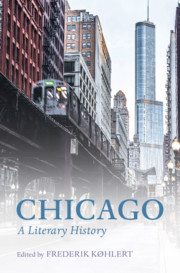Book contents
- Chicago: A Literary History
- Chicago
- Copyright page
- Contents
- Figures
- Contributors
- Acknowledgments
- Introduction: The Literary History of Chicago
- Part I The Rise of Chicago and the Literary West
- Part II Business Unusual: A New Urban American Literature
- Part III Radicalism, Modernism, and the Chicago Renaissance
- Chapter 11 Progressive Chicago: Upton Sinclair, Jane Addams, and Social Reform Literature
- Chapter 12 From the Prairie to the City: Willa Cather’s “City of Feeling”
- Chapter 13 Poetry, the Little Review, and Chicago Modernism
- Chapter 14 A Spirit of Two Ages: The Romantic Modernism of Carl Sandburg’s Chicago Poems
- Chapter 15 Building a Movement: Mary Reynolds Aldis and Little Theatre in Chicago
- Chapter 16 Father to Son: Floyd Dell, Sherwood Anderson, and the Chicago Renaissance
- Part IV A City of Neighborhoods: The Great Depression, Sociology, and the Black Chicago Renaissance
- Part V Traditions and Futures: Contemporary Chicago Literatures
- Selected Bibliography
- Index
Chapter 16 - Father to Son: Floyd Dell, Sherwood Anderson, and the Chicago Renaissance
from Part III - Radicalism, Modernism, and the Chicago Renaissance
Published online by Cambridge University Press: 02 September 2021
- Chicago: A Literary History
- Chicago
- Copyright page
- Contents
- Figures
- Contributors
- Acknowledgments
- Introduction: The Literary History of Chicago
- Part I The Rise of Chicago and the Literary West
- Part II Business Unusual: A New Urban American Literature
- Part III Radicalism, Modernism, and the Chicago Renaissance
- Chapter 11 Progressive Chicago: Upton Sinclair, Jane Addams, and Social Reform Literature
- Chapter 12 From the Prairie to the City: Willa Cather’s “City of Feeling”
- Chapter 13 Poetry, the Little Review, and Chicago Modernism
- Chapter 14 A Spirit of Two Ages: The Romantic Modernism of Carl Sandburg’s Chicago Poems
- Chapter 15 Building a Movement: Mary Reynolds Aldis and Little Theatre in Chicago
- Chapter 16 Father to Son: Floyd Dell, Sherwood Anderson, and the Chicago Renaissance
- Part IV A City of Neighborhoods: The Great Depression, Sociology, and the Black Chicago Renaissance
- Part V Traditions and Futures: Contemporary Chicago Literatures
- Selected Bibliography
- Index
Summary
This chapter examines the legacy of the Chicago Renaissance (1910–25) by focusing on the relationship between writers Sherwood Anderson and Floyd Dell. The chapter pays special attention to Dell’s late-life evaluation of Anderson – Anderson died in 1941, while Dell lived until 1969 – and draws extensively from Dell’s papers at the Newberry Library in Chicago, which underscore his hostility toward literary modernism as well as his associated dislike of Anderson. Although in the 1910s and 1920s, Dell was known as a bohemian writer/editor and leftist political figure, in later years, he became more conservative and tended to stress his allegiance to more traditional literary forms – in particular, realism – and to downplay his championship of the “new.” This tension between realism and modernism is evident in Dell’s ambivalent response to Winesburg, Ohio (1919), Anderson’s modernist-oriented portrayal of life in a small, Ohio town. The article also shows how these tensions may be seen in Chicago literature written after the Renaissance and notes that realism remained the dominant mode of representation during the 1930s and 1940s.
- Type
- Chapter
- Information
- ChicagoA Literary History, pp. 222 - 236Publisher: Cambridge University PressPrint publication year: 2021



